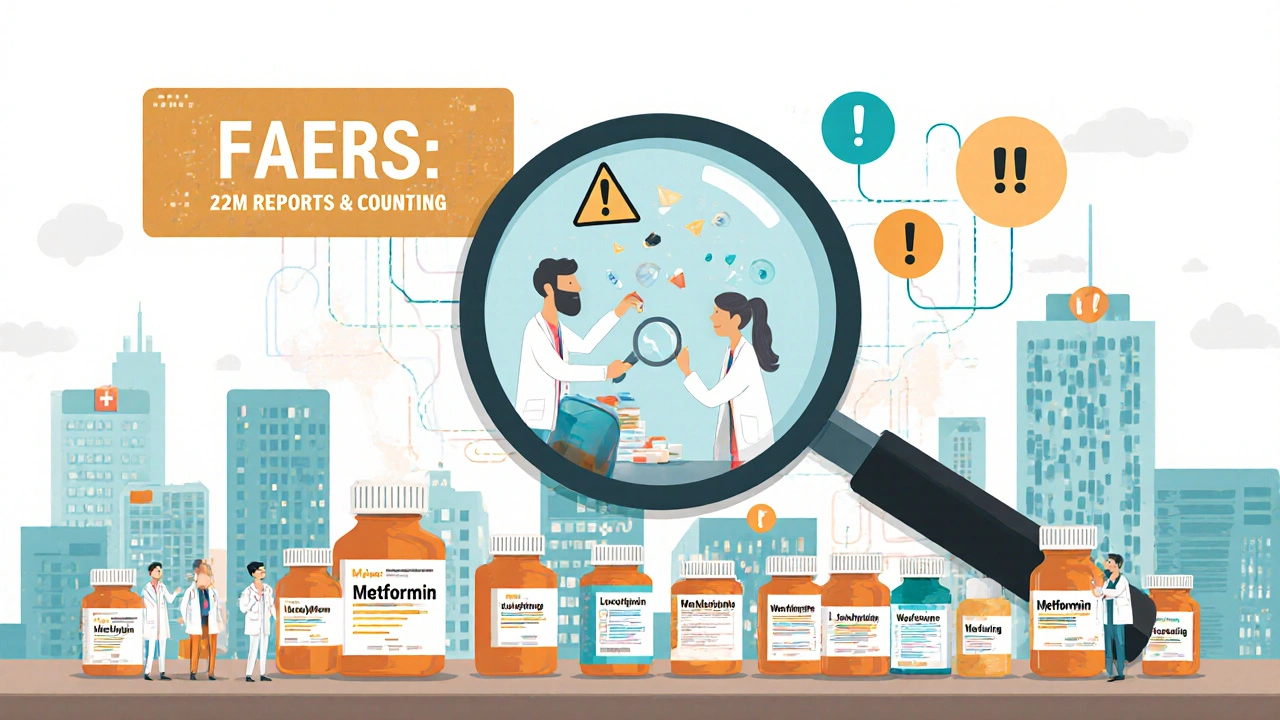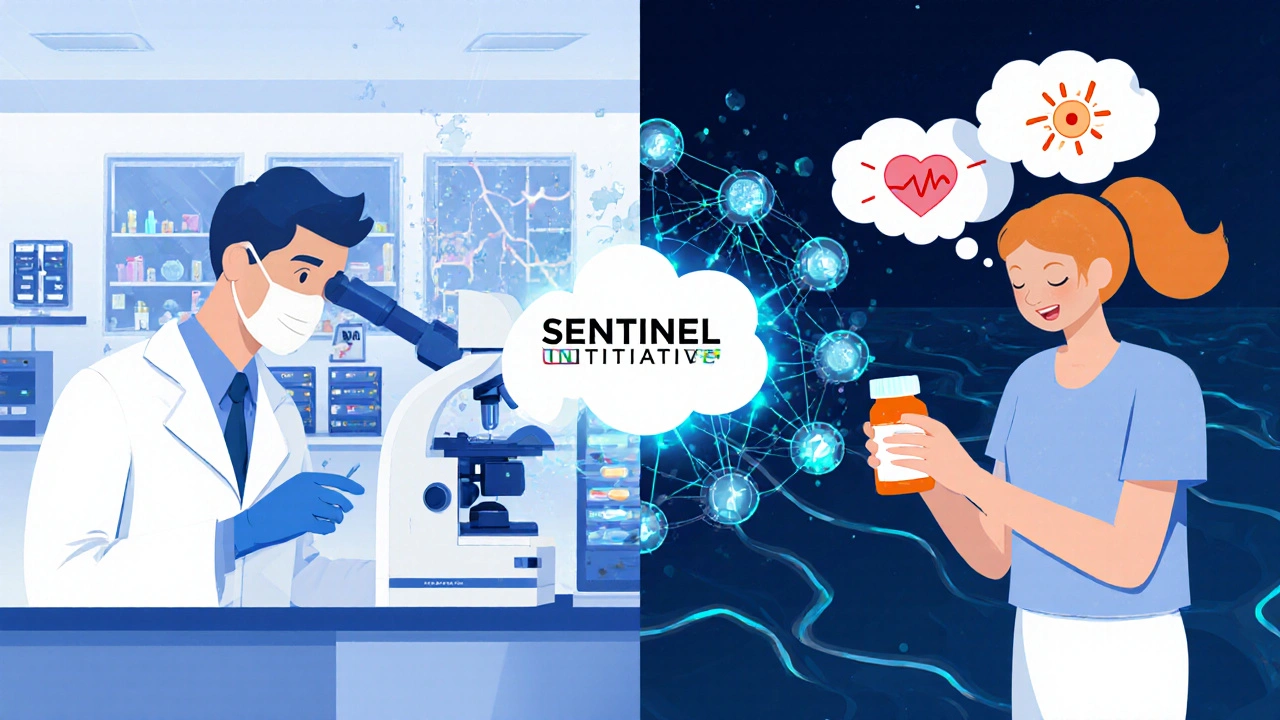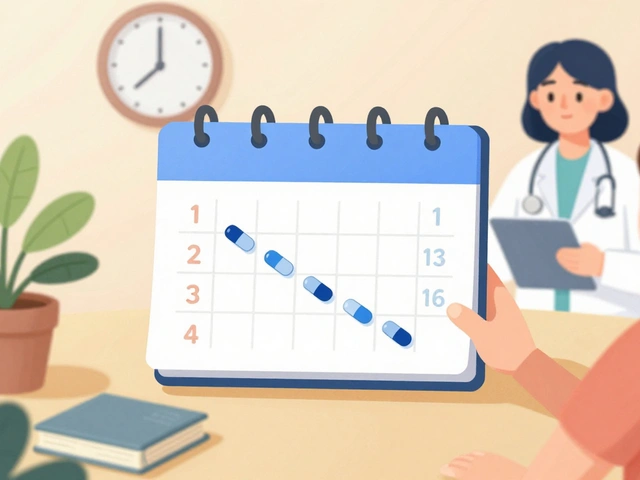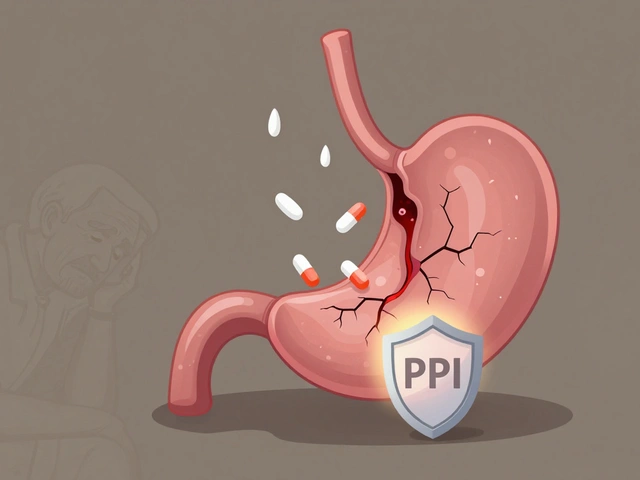
Every day, millions of Americans take generic drugs. They’re cheaper, widely available, and just as effective as brand-name medicines-or so we’re told. But what happens after the FDA approves a generic drug? Does the agency just walk away, assuming everything’s fine? Not even close.
Approval isn’t the finish line-it’s the starting line
The FDA doesn’t stop watching a generic drug once it hits the pharmacy shelf. In fact, the real safety work begins after approval. Before a generic drug gets the green light, it must prove it’s bioequivalent to the brand-name version. That means it delivers the same active ingredient at the same rate and amount in the body. These studies usually involve just 24 to 36 healthy volunteers. That’s not enough to catch every possible side effect.Real-world use is different. People have different genetics, other health conditions, take multiple medications, or react to inactive ingredients like dyes or fillers. That’s why the FDA has built a whole system to keep watching after approval. Their job isn’t to assume safety-it’s to prove it, over time, in real people.
The FDA’s safety net: FAERS and MedWatch
The backbone of this system is the FDA Adverse Event Reporting System, or FAERS. It’s a massive database that collects reports of side effects, allergic reactions, and other problems linked to medications. In 2022 alone, FAERS received about 2 million reports. About 1.4 million of those came through MedWatch, the FDA’s public reporting portal where doctors, pharmacists, and even patients can submit safety concerns.These aren’t just passive reports. The FDA has teams of epidemiologists, pharmacologists, and data scientists who dig into them. They look for patterns: Is a certain generic version of metformin suddenly linked to more stomach issues? Are more people reporting dizziness with a specific batch of levothyroxine? They use statistical tools to spot signals that might be ignored in a crowd of noise.
And they don’t wait for reports to come in. The FDA proactively mines MedWatch data for early warning signs-especially for generics that are widely used or have complex formulations. If a pattern emerges, they can trigger an investigation before it becomes a crisis.
Who’s watching the manufacturers?
Approval isn’t the end of quality control. The FDA still inspects manufacturing plants-both in the U.S. and overseas. In 2022, they conducted about 1,200 inspections at domestic facilities and 600 abroad. These aren’t scheduled visits you can prep for. Many are unannounced. Inspectors check everything: how raw materials are stored, whether equipment is cleaned properly, if lab tests are accurate, and if the final product matches what was approved.One major concern? Impurities. Even tiny amounts of unintended chemicals can build up over time and cause harm. The FDA’s Office of Pharmaceutical Quality (OPQ) works with the Office of Generic Drugs (OGD) to review impurity levels. If a generic manufacturer’s product shows impurities above safety thresholds, the FDA can demand changes, issue warning letters, or even block shipments.
The Sentinel Initiative: Real-time drug safety monitoring
One of the biggest leaps in recent years is the Sentinel Initiative. Launched in 2008 and expanded under the 21st Century Cures Act, Sentinel uses electronic health records from over 100 million patients across hospitals, clinics, and insurance systems. Instead of waiting for someone to report a problem, Sentinel actively scans for signs of harm.For example, if a new generic version of a blood thinner starts showing up in records with more cases of internal bleeding, Sentinel can flag it within weeks-not months or years. This system lets the FDA detect rare side effects that might only affect one in 10,000 people. It’s especially critical for generics, because their pre-approval safety data is so limited.

Why generics need extra scrutiny
Brand-name drugs go through years of clinical trials with thousands of patients. Generics? They skip most of that. They’re approved based on bioequivalence, not full-scale safety trials. That means the FDA has to make up for that gap after approval.Even small differences matter. A generic version of a seizure drug might use a different filler. For most people, it’s harmless. But for someone with a rare allergy or metabolic issue, that filler could change how the drug is absorbed. The FDA calls these “allowable differences,” and they’re a known blind spot. Experts warn that for narrow therapeutic index drugs-like warfarin or lithium-even tiny changes can lead to serious outcomes.
The FDA doesn’t ignore this. They’ve created special review protocols for complex generics: inhalers, injectables, topical creams, and extended-release pills. These aren’t simple copies. They’re hard to replicate, and their safety needs deeper monitoring.
What happens when something goes wrong?
If the FDA finds a real safety issue, they don’t wait. Actions can include:- Updating the drug’s label to add new warnings
- Issuing a “Dear Healthcare Provider” letter to alert doctors
- Requesting a voluntary recall
- Blocking future shipments from the manufacturer
- In rare cases, pulling the drug off the market entirely
These decisions aren’t made lightly. They’re based on multiple lines of evidence: FAERS data, Sentinel findings, manufacturing inspections, and lab analysis. The FDA doesn’t react to a single report. They look for consistent, statistically significant patterns.
The numbers don’t lie
Generic drugs make up 90% of all prescriptions filled in the U.S. but cost only about 23% of total drug spending. That’s why their safety matters so much. A problem with one widely used generic can affect millions. In 2023, the FDA approved around 1,000 new generic drugs. Each one enters the market with less safety data than its brand-name counterpart.That’s why the FDA spends about $65 million a year on post-market monitoring, funded by user fees from generic manufacturers under the GDUFA program. GDUFA III, which started in 2023, includes even stronger requirements for tracking complex generics and improving data sharing.

What’s still missing?
The system is better than it’s ever been-but it’s not perfect. Experts estimate that only 1% to 10% of adverse events are ever reported. Many patients don’t know how to report. Doctors are busy. Pharmacies don’t always track which generic brand was dispensed.Also, while Sentinel covers 100 million patients, that’s still only about a third of the U.S. population. Coverage is expanding, but gaps remain. And for some complex generics-like inhaled steroids or transdermal patches-the science to prove bioequivalence is still evolving.
Still, the FDA’s approach is one of the most advanced in the world. Unlike Europe, which uses a single centralized system, the U.S. relies on multiple tools working together. But that’s also a strength: redundancy. If one system misses something, another might catch it.
What you can do
You don’t have to wait for the FDA to act. If you think a generic drug caused a side effect:- Write down the drug name, dose, and when you started taking it
- Note the side effect and when it started
- Report it to MedWatch at fda.gov/medwatch
- Ask your pharmacist which generic manufacturer made your pills-sometimes, switching brands helps
Your report could be the first clue in a pattern that saves others from harm.






15 Comments
Generics are the unsung heroes of American healthcare. Most people don’t realize how much work goes into making sure that $5 pill works just like the $50 one. The FDA’s system isn’t perfect, but it’s lightyears ahead of what most countries even dream of.
The FDA’s entire post-market surveillance framework is a national security imperative-bioequivalence studies with 36 people? That’s not science, it’s a gamble with public health. And yet, we let this happen because of cost-cutting? We’re not just under-regulating-we’re enabling systemic risk. The GDUFA funding is a Band-Aid on a hemorrhage.
India makes 40% of the world’s generics-and the FDA inspects our plants? Hah! You think they find anything? I’ve seen labs in Gujarat where the QA team uses Excel sheets to track batch numbers. The FDA’s ‘unannounced’ inspections? They get a 3-day heads-up via WhatsApp from the plant owner’s cousin. This whole system is a farce.
Let me be clear-this isn’t about safety. This is about control. The FDA doesn’t want you to know how thin the line is between ‘effective’ and ‘toxic.’ They want you to believe the system works. But if you dig into the FAERS data, you’ll see the same drugs flagged repeatedly-only to be buried under bureaucratic noise. This isn’t oversight. It’s theater.
im kinda surprised they even have the resources to do all this. i didnt know they used sentinel like that. also, i think most people dont realize how hard it is to replicate a complex generic-like inhalers or patches. its not just copying the pill. its like reverse-engineering a rocket engine with duct tape
They’re lying to you. Every single one of these ‘safe’ generics? Half of them have impurities that would get a pharmaceutical company shut down in Europe. The FDA? They’re on the payroll of Big Pharma. They don’t want to scare you off generics-they want you to keep buying them, even if they’re slowly poisoning you. Check the impurity logs. You’ll see the same names over and over. And they’re still approved. Why? Because profit > people.
Did you know the FDA gets paid by the drug companies they’re supposed to regulate? GDUFA? That’s not user fees-that’s a bribe. And those ‘unannounced’ inspections? They’re scheduled in advance. The plants clean up for a week, then go back to normal. And Sentinel? It only covers 1/3 of the population. The rest of us? We’re lab rats. They’re watching us, not protecting us.
There’s something deeply human here. We demand perfection from medicine, yet we accept the bare minimum in oversight because it’s cheap. We treat drugs like commodities, not life-sustaining tools. The FDA’s system isn’t broken-it’s a reflection of our priorities. We value convenience over consequence. Efficiency over ethics. And we wonder why people distrust the system
I work in a rural clinic and I’ve seen patients switch generics and have seizures because the filler changed. No one told them. No one tracked it. The FDA’s system is brilliant in theory-but in practice? It’s invisible to the people who need it most. We need better labeling. We need pharmacists to tell patients which company made their pill. We need to stop treating patients like numbers.
OMG I JUST REALIZED MY LITHIUM IS FROM A DIFFERENT BRAND NOW. I’VE BEEN HAVING TERRIBLE TREMORS. I THOUGHT IT WAS STRESS. IS THIS WHY?? I’M GOING TO REPORT THIS RIGHT NOW. I HOPE THIS HELPS SOMEONE. I’M SO ANGRY.
It’s funny how everyone acts like generics are this miraculous cost-saving miracle. They are. But the truth is, the FDA is playing whack-a-mole with 1,000 new generics a year and a staff that hasn’t meaningfully grown since 2010. The system is stretched so thin it’s transparent. And yet, we still manage to catch the worst offenders-barely. That’s not a success story. That’s a near-miss epidemic.
They’re using your health data to train AI. Sentinel isn’t for safety-it’s for predictive control. They’re building profiles on who reacts to what. Who’s prone to side effects? Who’s likely to report? That data? It’s sold to insurers. They’ll raise your premiums if your pill triggers a ‘risk signal.’ This isn’t monitoring. It’s surveillance capitalism dressed in lab coats.
Report it. Even if you think it’s nothing. I did. Three months later, my generic metformin was recalled. It wasn’t me. It was the 12 others who reported the same thing. Your voice matters. Don’t wait for someone else to speak up.
India makes 70% of the world’s generic APIs-and the FDA still approves them? 😂 Bro, I’ve seen the labs. They reuse glassware without cleaning. The inspectors? They get free chai and a tour. But hey, at least the price is low, right? 🤷♂️ #GlobalPharmaReality
So the FDA watches generics but doesn’t care about the environmental impact of all those manufacturing plants in China and India? The waterways are full of pharmaceutical runoff. No one talks about that. But hey, your blood pressure med is $3. So it’s fine, right?